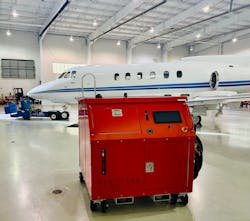A Digital 'Mule' for Hydraulic Systems Testing
Aircraft maintenance technicians (AMT) can appreciate that FlyTek GSE hydraulic power units (HPUs) are designed with their work in mind.
The job of the HPU, sometimes referred to as a “mule,” is to provide auxiliary power to an aircraft for the purpose of maintaining and repairing the aircraft’s hydraulic systems.
The HPU provides a source of pressurized hydraulic fluid. The unit filters, cools and supplies hydraulic oil under steady pressure to test the hydraulic systems of an aircraft without having to start the engines. These systems include landing gear, brakes, flaps, gear swings, thrust reversers and flight controls.
When operating the HPU, an operator can specify pressure and flow rate. All FlyTek HPUs are fully digital. A one-touch digital display replaces knobs and dials with an intuitive, user-friendly interface. Using the touchscreen, an operator enters the desired pressure and flow.
The HPU is a self-contained unit – no laptops or other devices are required, but because the HPU is Wi-Fi enabled, it can be controlled remotely with a tablet or phone.
“Our customers have used this feature to eliminate the need for personnel to go back and forth between the cockpit to do gear swings while changing pressure and flow remotely for various functions,” FlyTek Business Manager Junaid (Jay) Mukhtar said.
If problems arise, troubleshooting can be done remotely.
“Essentially there is a computer on board, and we can remotely access the control panel to see if there are any technical issues,” he said. “While this will not eliminate physical issues – leaks, weeping hoses, etc. – we can check any functionality errors. Physical issues can be seen in person.”
With an aluminum frame lighter weight than most HPUs, and with heavy-duty casters, FlyTech HPUs are easy to roll.
Easy Upkeep
An aspect AMTs will be sure to appreciate is the HPU's ease of maintenance the HPU requires. For instance, HPU filters and service points are easy to access.
“Having equipment that’s easy to operate and maintain ensures that there is less downtime as it can be costly to the operation,” said Mukhtar.
Preventative maintenance can be done on site by FlyTek. According to Mukhtar, some of the most important aspects of HPU maintenance include checking and changing the oil, changing filters, and checking for and fixing leaks, such as from fittings, weeping hoses or bad components.
Different units can have different maintenance schedules depending on the instructions from their manufacturer. Generally, Mukhtar said it is recommended to change filters yearly and hoses every 2-4 years, depending on their condition.
Other features include on-board hose flushing connections, which eliminate the need for a run-around block, a built-in tool compartment to keep tools close at hand, and a fully welded drip pan, which comes standard on all units. With the welded drip pan, Mukhtar said there will be no more hydraulic fluid messes on the floor – in the event of a small leak, he said the unit will contain the spill.
The hydraulic fluid is phosphate ester or mineral base hydraulic fluid, and Mukhtar outlined differences between the two.
Phosphate ester hydraulic fluids are synthetic fluids that are made from phosphoric acid and alcohols. They are known for their fire resistance and are often used in aircraft that require high-temperature performance, such as military aircraft or those that operate in extreme environmental conditions. Phosphate ester fluids also have good anti-wear properties and are less likely to corrode metal components.
Mineral base hydraulic fluids, on the other hand, are petroleum-based fluids that are made from refined crude oil. They are generally less expensive than phosphate ester fluids and are often used in commercial aircraft where fire resistance is less critical. Mineral base fluids have good lubricating properties but can be more susceptible to corrosion and may require more frequent maintenance.
To monitor the quality of the fluid, a contamination monitor is available as an option on the HPU. “This counts the particulates and ensures the oil is in a safe condition to use,” Mukhtar said.
To meet different aircraft needs, HPUs come in different configurations. FlyTek currently offers 10 Gallons Per Minute (GPM) with 3500 PSI, 20 GPM with 3500 PSI, 30 GPM with 3500 PSI, True Dual 15/15 GPM with 3500 PSI and True Dual 30/20 with 3500 PSI.
When shopping for an HPU, Mukhtar suggests considering pressure limits, power capacity, reservoir volume, unit size and power supply.
About the Author
Rebecca Kanable
Assistant Editor
Rebecca Kanable, a veteran journalist, worked with Endeavor Business Media's aviation group from 2021 to 2024 as assistant editor of Airport Business, AMT and Ground Support Worldwide. She previously worked for various publications, including trade magazines and newspapers.

